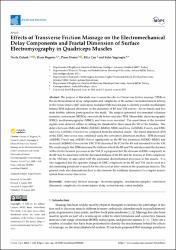Effects of Transverse Friction Massage on the Electromechanical Delay Components and Fractal Dimension of Surface Electromyography in Quadriceps Muscles
Citation
Ozturk, N., Begovic, H., Demir, P., Can, F., & Yagcioglu, S. (2023). Effects of Transverse Friction Massage on the Electromechanical Delay Components and Fractal Dimension of Surface Electromyography in Quadriceps Muscles. Fractal and Fractional, 7(8), 620.Abstract
The purpose of this study was to assess the effects of transverse friction massage (TFM) on the electromechanical delay components and complexity of the surface electromechanical activity in the rectus femoris (RF) and vastus medialis (VM) muscles and to identify possible mechanisms behind TFM-induced alterations in the dynamics of RF and VM activity. Seven female and five male healthy subjects participated in this study. The subjects generated five maximal voluntary isometric contractions (MVICs) consecutively before and after TFM. Meanwhile, electromyography (EMG), mechanomyography (MMG), and force were recorded. The onset times of the recorded signals were detected offline by setting the threshold to three times the SD of the baseline. The delays between EMG and MMG (Δt(EMG–MMG)), MMG and force (Δt(MMG–Force)), and EMG and force (Δt(EMG–Force)) were computed from the detected onsets. The fractal dimension (FD) of the EMG time series was computed using the correlation dimension method. TFM increased Δt(MMG–Force) and Δt(EMG–Force) significantly in the RF but decreased Δt(EMG–MMG) and increased Δt(MMG–Force) in the VM. TFM decreased the FD in the RF and increased it in the VM. The results imply that TFM decreased the stiffness of both the RF and VM and decreased the duration of the electrochemical processes in the VM. It is proposed that the decrease in EMG complexity in the RF may be associated with the decreased stiffness of the RF, and the increase in EMG complexity in the VM may be associated with the decreased electrochemical processes in this muscle. It is also suggested that the opposite changes in EMG complexity in the RF and VM can be used as a discriminating parameter to search for the effects of an intervention in the quadriceps muscles. The present study also demonstrates how to discriminate the nonlinear dynamics of a complex muscle system from a noisy time series.

















